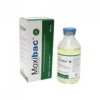Description:
Indication
An antibiotic called Moxibac IV is used to treat bacterial infections. Additionally, it is used to treat infections of the lungs, nose, throat, skin, and soft tissues (pneumonia). By preventing the growth of the causing microorganisms, it eliminates the infection. When oral administration is not an option, such as with hospitalized or unconscious patients, Moxibac IV is administered intravenously (IV). It is given by a medical professional.
Pharmacology
Moxifloxacin is a 4th generation synthetic broad-spectrum antibacterial drug that belongs to the fluoroquinolone class of antibiotics. It is effective against a wide variety of bacteria, including gram-positive, gram-negative, anaerobic, and atypical Mycoplasma pneumonia. Topoisomerase II (DNA gyrase) and topoisomerase IV are inhibited, which are required for bacterial DNA replication, transcription, and repair.
Dosage & Administration
The dose of Moxifloxacin is 400 mg once daily. The duration of therapy depends on the type of infection as described in the following:
- 400 mg once daily for 10 days for acute bacterial sinusitis
- Bronchitis caused by an acute bacterial infection: 400 mg once daily for five days.
- Community Pneumonia: 400 mg once daily for 7?14 days if acquired.
- Simple infections of the skin and skin structure: 400 mg once daily for seven days.
- Infections of the Complex Skin and Skin Structure: 400 mg once daily for 7?21 days.
- Intra-abdominal infections that are complicated: 400 mg once daily for 5?14 days.
Interaction
There is no evidence that intravenous fluoroquinolones interact with didanosine, oral antacids, sucralfate, multivitamins, or metal cations. However, no solution containing multivalent cations, such as magnesium, should be administered through the same intravenous line as a fluoroquinolone. It has been demonstrated that quinolones, like Moxifloxacin, enhance the anticoagulant effects of warfarin and its derivatives in patients. Although this has not been observed in preclinical and clinical trials with Moxifloxacin, concurrent treatment with a nonsteroidal anti-inflammatory drug and quinolone may increase the risk of CNS activation and convulsions.
Contraindications
Persons who have a known hypersensitivity to Moxifloxacin or other quinolone antibacterials should avoid taking it.
Side Effects
Treatment with Moxifloxacin (oral, IV, or sequential therapy) may cause some side effects. Common (>1%) side effects include headache, nausea, vomiting, diarrhea, constipation, abdominal pain, dyspepsia, dizziness, pyrexia, insomnia, etc. Less common (0.1 to <1%) side effects include neutropenia, palpitations, tachycardia, bradycardia, vertigo, tinnitus, dry mouth, gastritis, edema, fatigue, malaise, hyperglycemia, anorexia, hyperlipidemia, hypoglycemia, dehydration, back pain, and arthralgia, etc.
Pregnancy & Lactation
Pregnancy Classification C. Because there have been no appropriate or well-controlled studies in pregnant women, Moxifloxacin should only be used during pregnancy if the possible benefit outweighs the risk to the fetus. The antibiotic moxifloxacin is excreted in the milk of rats. Human milk may also include moxifloxacin. Because of the risk of major adverse reactions in nursing infants from women taking Moxifloxacin, a choice should be made whether to stop breastfeeding or stop taking the medicine, taking into account the drug’s importance to the mother.
Precautions & Warnings
Fluoroquinolones, such as Moxifloxacin, have been linked to a higher incidence of tendinitis and tendon rupture in people of all ages. Fluoroquinolone-associated tendinitis and tendon rupture are more likely to occur in people over 60 years old, those who take corticosteroid medicines, and those who have had a kidney, heart, or lung transplant. The neuromuscular inhibiting effect of fluoroquinolones may aggravate muscle weakness in people with myasthenia gravis. Nearly all antibacterial drugs, including Moxifloxacin, have been linked to Clostridium difficile-associated diarrhea (CDAD), which can range in severity from mild diarrhea to deadly colitis.
Storage Conditions
Store below 25?C and protect from light. Avoid extreme heat and freezing. Keep out of reach of children.







Reviews
There are no reviews yet.